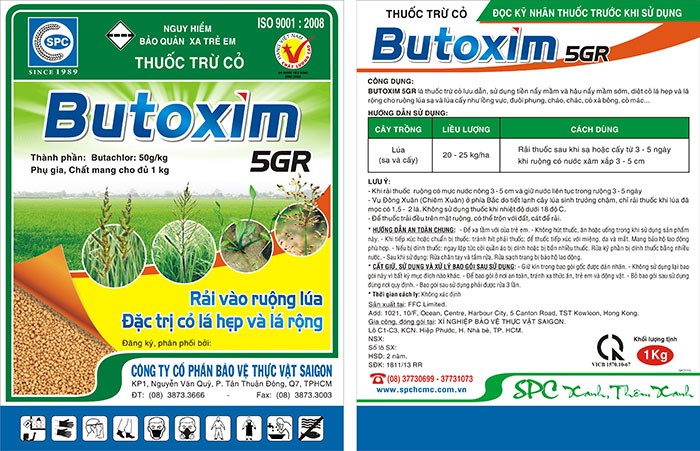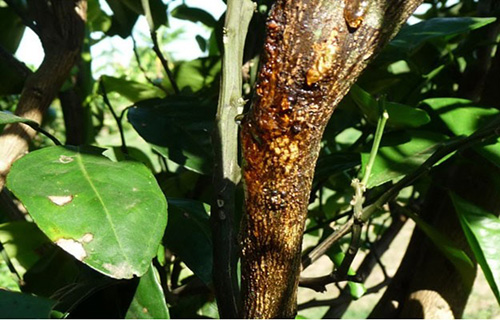|
BUTOXIM 5GR HERBICIDE FOR THE RICE FIELD
21/06/2023
BUTOXIM 5GR HERBICIDE FOR THE RICE FIELD 17/06/2022 Outstanding features and usage of Butoxim 5GR product are: The product is granular, containing 50g of herbicide in 1kg of finished product. Butoxim 5 GR with active ingredient Butachlor can eliminate many types of weeds such as Leptochloa chinensis , Echinochloa sp , Cyperus difformis , Fimbristylis miliacea , Monochoria vaginalis ,Marsilea quadrifolia ,Rotala indica etc… The product has a systemic effect, penetrates mainly into roots and sprouts, and acts as an herbicide in the early pre-emergence and post-emergence stages, from the time the weed seeds sprout until 1-2 leaves appear. Butoxim 5 GR is easy to use and safe for rice Dosage: from 20-25kg/Ha. Spread the product evenly on the field immediately after sowing or transplanting from 3-5 days. When spraying the field, the water level must be 3-5 cm and keep water for 3-5 days continuously. Note when using: In the Spring-Summer crop in the North due to the cold weather, rice plants grow slowly, only spray when the rice plants have 1.5-2 leaves and do not use products when the temperature is below 180C. To evenly distribute the product on the field, it can be mixed with soil and sand to spread. Do not let the field dry and crack after spraying. Before using the product, you need to carefully read the manufacturer instructions on the product packaging to apply. I wish fellow farmers a bumper crop of Summer-Autumn and getting price
|
Miner has the scientific name Phyllocnistis citrella Staint., family Phyllocnistidae, order Lepidoptera. The miner occurs in many countries in the tropics and subtropics. The main host of the miner is the citrus family - Rutaceae. In addition, the miner also attacks mangosteen and some other plants.
Adult is a small planthopper, with a body 2-3 mm long, the whole body is ash gray, slightly greenish, the wings are opaque with many small brown spots.Eggs are oval, 0.3 mm long, have a pointed end and are attached directly to the leaf surface, leaf axils.
Green bugs specialize in the fruit of citrus groups (oranges, tangerines, lemons, grapefruits, kumquats...), some people call them orange bugs, or orange suckers. Their scientific name is Rhynchocoris poseidon or Rhynchocoris humeralis.
In Vietnam, yellow leaf curl disease is very common on papaya trees, especially the disease is often severe in areas of high and continuous planting, areas with hot and arid climates. The disease has significantly reduced the yield and quality of papaya. Gardens that are infected early when the plants are young may not yield. However, up to now, many gardeners still do not know the cause and how to fix it.
Spider mites are common pests on citrus trees, especially in hot and dry climates that are suitable for spiders to grow and cause severe damage.The group of harmful spiders is usually very small in size, unlike the natural enemy spiders.
This group includes species that are generally very small in size, causing damage by sucking plant sap (on leaves, fruits, branches, stems).
There are many species of mealybugs present on the group of Oranges,Tangerines,Grapefruits and Lemons (Citrus), which can be divided into 2 groups:
+ Group of sticky mealybugs with common varieties such as Lepidosaphes, Aonidiella, Coccus and Saissetia.
+ Group of flower mealybugs with common genera and species such as Pseudococcus, Planococcus and Icerya purchasi.
Dry branches and berries disease often appear to be common damage on coffee gardens during the rainy season. The disease causes death of branchs, dry fruit, severely affects the canopy structure and coffee yield if not paid attention to prevention.
Pink disease commonly causes diseases on rubber plantations in the rainy season, especially on garden from 4-8 years old. This year, rubber has to go through a period of severe drought, weakening the tree, so now in tnshe rainy season it is easy to get infected. Therefore, it is necessary to pay attention to good management to avoid affecting the garden.
In recent years, the area of citrus has been expanded because it is a fruit tree with high economic efficiency. However, in order to sell at a high price, not only in quality but consumers also require the external beauty of the fruit, so pest management on citrus is a matter of great concern to farmers. The hot season is a favorable condition for thrips to develop and cause damage, affecting the commercial value of fruit.
Currently in Vietnam, the cultivation of citrus trees is playing an important role in the country agricultural production. The benefits of citrus trees have made many farmers rich. However, wherever citrus trees are planted, fissured trunk cracking appears and causes damage. If any gardener is negligent or lacks attention to this disease, the tree will die, even the whole garden.
- Headquarters
- SAIGON PLANT PROTECTION JOINT STOCK COMPANY
- RQ 1, Nguyen Van Quy St., Tan Thuan Ward, HCM City
- Tax code: 0300632232
- Tel: (028) 38 733 295 - 38 732 077
- Fax: (028) 38 733 003 - 38 733 391
- Website: www.spchcmc.vn - Email: info@spchcmc.vn
- SAIGON PLANT PROTECTION COMPANY
- SAIGON PLANT PROTECTION JOINT STOCK ENTERPRISE
- Lot C1-C3 Hiep Phuoc Industrial Park, Hiep Phuoc Commune, HCM City
- Tel: (028) 3873 4089 - Fax: (028) 3873 4086
- Affiliated Unit
-
- Quick Links
- Home
- About us
- Career Opportunities












